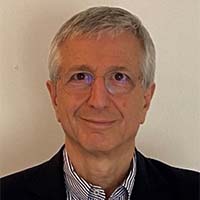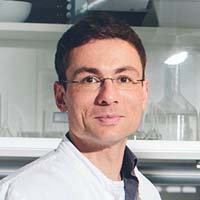Due to the multidisciplinary and integrated approach, NeuroPhage success stands on the following complementary partner contributions: chemical and molecular biology engineering of NanoPhage systems (IRCSS, UniBO), biophysical, functional and biological characterization in vitro (IRCCS, UCD), brain targeting and pharmacokinetics (HZDR, CU) and finally evaluation of the effects of neurostimulation on signal transduction and basal ganglia output in normal and Parkinsonian mice (INSERM, KI).
Our Principal Investigators
🔗 Prof Fabio Benfenati (IRCCS)
MD, Neurologist. Director of the NSYN Center, full professor of Neurophysiology at the Department of Experimental Medicine, University of Genova, Fogarty and Fullbright fellow and Adjunct Professor, The Rockefeller University, New York, NY.

Read more
Neurophysiologist and neurologist who gave important contributions to the mechanisms of synaptic transmission and plasticity, following up his long-standing collaboration with Nobel laureate Paul Greengard. In 2006, he founded the Neuroscience Department at the Italian Institute of Technology and, since then, he started the interdisciplinary field of neural interfaces, particularly light-sensitive interfaces, at the border between neuroscience and nanotechnology. Besides optogenetics, he has pioneered and fully developed the extremely original field of light- controlled organic nanoactuators to trigger light-driven neuronal activation. This allows to interrogate specific brain circuits and compensate for nervous system pathologies in which neuronal degeneration has induced a loss of function. In the last 10 years or so, he published a large number of high impact papers on the evolution and engineering of these interfaces from in vitro primary neurons and ex vivo degenerate retinas up to the in vivo rescue of degenerative blindness in genetically altered animals. The impact and significance of these discoveries on human degenerative diseases are extremely promising. He is author of high ranking research papers in top journals such as Science (1), Nature (2), Neuron (2), Nature Materials (1), Nature Photonics (1), Nature Nanotechnology (2), Nature Communications (5), Nature Neuroscience (1), J Cell Biology (5), J Clin Invest (2), EMBO J (3), Proc Natl Acad Sci USA (12), Cell Journals (1 Cell Stem Cell, 3 Cell Reports), Brain (3), and co-inventor of 8 patents. H-index=83 (Google Scholar); over 23000 citations; total impact factor > 1000.
🔗 Prof Kenneth Dawson (UCD)
Director of CBNI, and lead investigator of the bio-nanoscience activities in UCD, and Chair of Physical Chemistry, who has authored > 320 publications (h-index>60; citation>20,500)

Read more
Prof Kenneth Dawson is the Director of CBNI, and lead investigator of the bio-nanoscience activities in UCD, and Chair of Physical Chemistry, who has authored > 320 publications (h-index>60; citation>20,500). His work has focused on bio-nanotechnology, exploring the application of NPs in biological samples, such as diagnostics, immunological capture, and bio-nano interactions of living systems. Prof. Dawson is recognized as a leading thinker on the principles governing the interactions of nanoscale entities with living organisms, and implications for bionanoscience. He is the founder of the modern conception of the ‘protein (biomolecular) corona’ responsible for the biological identity of engineered nanoparticles. He has been a member of European Commission scientific committees, including the SCENIHR committee on regulations for new risk in the EU, the European Medicines Agency, and the European Science Foundation, as well as other foundations and agencies world-wide. He is a recipient of the web of science “highly cited researchers” award for both 2018 and 2019. Prof. Dawson was awarded the RSC Harrison medal, and became one of the youngest Weir fellows at Oxford University, and went on to win a Lindemann fellowship to conduct research in the US. There he won the Sloan, Dreyfus, and Packard Prize and Fellowship. In 2007 he won the Cozzarelli Prize for his work on the protein corona, an award that recognizes outstanding contributions to the scientific disciplines represented by the US National Academy of Sciences. Prof. Dawson has extensive experience with coordination and participation in both EU and National projects.
🔗 Dr Kristof Zarschler (HZDR)
Biologist with an excellent expertise in functionalization, radiolabeling and in vitro characterization of proteins, peptides and nanomaterials. He brings along a strong background in molecular biology, biotechnology, nanotechnology, radiopharmaceutical chemistry, and cell biology.

Read more
Kristof Zarschler received his PhD with distinction from the Department of Nanobiotechnology at the University of Natural Resources and Life Science Vienna, Austria in 2009. During his PhD, he gained extensive expertise in ultrastructural properties of protein nanoassemblies as well as the expert knowledge of gene expression, surface display, and cell biology. Before Kristof Zarschler joined the Nanoscalic Systems group headed by Dr Holger Stephan at the IRCR of the HZDR as a research associate in 2011, he was postdoctoral research associate at the Institute for Genetics of the Technical University Dresden (2010-2011). At IRCR, he acquired broad experience in the handling of radionuclides including radiolabeling and in vitro characterization of chelators, proteins and nanoparticles.
🔗 Prof Luděk Šefc (CU)
Head of CAPI. His research is focused on experimental hematology, stem cell research, hyperbaric medicine, and multimodal in vivo imaging of small laboratory animals.

Read more
Prof Luděk Šefc, PhD, is head of CAPI. His research is focused on experimental hematology, stem cell research, hyperbaric medicine, and multimodal in vivo imaging of small laboratory animals. He participates on development on new in vivo imaging devices (single-layer Compton camera for CT, SPECT, and PET imaging, optical imaging in SWIR). He is author of > 50 research papers in peer-reviewed international journals, including: JACC (1), Biomaterials (1), Carbon (1), Journal of Controlled Release (3), Stem Cells (4), Nanoscale (1). H-index=15 (google scholar); over 700 citations; total impact factor > 200. Luděk Šefc participates in the European COST project CA17121 – Correlated Multimodal Imaging in Life Sciences (COMULIS) joining 36 European and associated countries as a Leader of Workgroup 2 for Preclinical Hybrid Imaging.
🔗 Prof Gilberto Fisone (KI)
Prof Gilberto Fisone received his training in biology at the University of Pavia (Italy) and his PhD at the University of Stockholm (Sweden). In 1990, he joined the laboratory of Dr. Paul Greengard at the Rockefeller University (New York).

Read more
Prof Gilberto Fisone received his training in biology at the University of Pavia (Italy) and his PhD at the University of Stockholm (Sweden). In 1990, he joined the laboratory of Dr. Paul Greengard at the Rockefeller University (New York). He later received a position as an assistant professor at the Rockefeller University. Since then, he has been studying the molecular mechanisms underlying neurotransmission in the basal ganglia. In 1995, Dr. Fisone took a job as an assistant professor in the Department of Neuroscience of Karolinska Institutet (Stockholm), where he is currently Professor and Chair. During the last 15 years, Dr. Fisone’s laboratory has acquired considerable experience in the use of toxin-based models to reproduce biochemical abnormalities and motor deficits associated with Parkinson’s disease (PD). His research has identified a number of molecular targets implicated in the motor side effects (i.e. dyskinesia) caused by repeated administration of L-DOPA. More recently his laboratory characterized a mouse model displaying cognitive deficit, affective dysfunctions and other co-morbidities observed in the early stages of PD. Overall, these findings helped to identify molecular targets for the treatment of motor and non-motor conditions in PD.
🔗 Dr Jean-Antoine Girault (INSERM)
MD, PhD, was trained in Biochemistry and Medicine in Paris. He did a Neurology residency, a PhD in Molecular and Cellular Pharmacology with Jacques Glowinski at the Collège de France and a post-doc (1985-1989) at the Rockefeller University in New York with Paul Greengard.

Read more
He then headed a research group at the Collège de France (1990-1999). He created a new Inserm unit at the Fer-à-Moulin site in Paris (2000-2006). In 2007, JA Girault became director of the newly created Institut du Fer-à-Moulin, a research institute investigating the development and plasticity of the nervous system and affiliated with Inserm and the Pierre & Marie Curie University (UPMC, now Sorbonne University since 2018). JA Girault also coordinated the creation and directed the Paris School of Neuroscience (2007-2010) and, since 2012 he heads the “Biology for Psychiatry Laboratory of excellence” (Bio-Psy Labex), a network of basic and clinical research groups aiming at strengthening translational neuroscience and psychiatry research in Paris area. He is currently the President elect of the Federation of European Neuroscience Society (FENS). He has regular teaching activities and service in scientific boards and panels as well as in learned societies at the national and international levels. Scientific output: 202 publications in PubMed (Web of Science: >14700 citations, H = 68, Google Scholar: >19900 cites, H = 76).
🔗 Prof Matteo Calvaresi (UniBO)
Associate Professor at the University of Bologna. He has been working at the cutting edge between nanotechnology and biology. MC leads a multidisciplinary research group (NanoBio Interface Lab) at the Department of Chemistry “Giacomo Ciamician”.

Read more
The PI is an internationally recognized scientist in the field of nanomedicine: he was invited speaker in important international conferences of the field. From 2017, he is the Deputy Coordinator of the PhD course in “Nanoscience for Medicine and the Environment” at the University of Bologna. From 2018 he joined to the “Interdepartmental Centre for Applied Research on Health Sciences & Technologies”. MC is author of more than 100 papers with >1800 citations and h-index = 24. MC has published in the major international peer-reviewed multi-disciplinary scientific journals and in the leading chemical and nanotechnological journals as Nature Nanotechnology, PNAS, Acc. Chem. Res., JACS, Angew. Chem., ACS Nano, Material Horizons, Adv. Functional/ Healthcare Materials, Biomaterials, Small, Nanoscale et al. He is associated Editor of “Molecules” (Section Board for “Nanochemistry”). He was visiting researcher/visiting Professor at the Peking University (China), University of Pune (India) and at The Technion – Israel Institute of Technology (Israel). In 2016 MC was the recipient of an Italian grant of €388000, in the program entitled “The Scientific Independence of young Researchers (SIR) programme” with the project: BIOTAXI – Hybrid fullerene/protein-carriers to target cancer cells. In 2020 MC was awarded a prestigious My first AIRC grant for five years (€498000) for the project NanoPhage – An Innovative Hybrid Platform for Targeted Sono- Photo- Dynamic Cancer Therapy. MC participated to many Italian and European (FP7 and H2020) projects.
🔗 Prof Alberto Danielli (UniBO)
Associate Professor of Molecular Biology at the Department of Pharmacy and Biotechnology (University of Bologna).

Read more
He has a strong background in fundamental research on gene regulation and molecular cell biology of infectious pathogens. Recently he has also been involved in phage biotechnological research, combining molecular techniques with synthetic biology approaches to exploit filamentous phages as therapeutic vectors, as well as nanobiotechnological scaffolds for biosensors and bio-conjugations. AD participated to many research programs and has been awarded several research grants as independent PI. He is author of numerous research articles in the field of molecular microbiology published in major international peer-reviewed multi-disciplinary scientific journals, including Science, PNAS, Nature Communications, Nucleic Acids Research, PLoS Pathogens, Molecular Microbiology, FEMS Microbiology Reviews, etc. He is member of the Italian Society of General Microbiology and Microbial Biotechnology (SIMGBM) and of the EMBL Alumni Association. AD has developed a line of retargeted M13 phages for non-invasive tissue-penetrating photosonodynamic treatment of pathogenic bacteria and cancer cells. The phage platform is functionalized on the viral capsid with hundreds of sensitizers for PSDT and the phage can be engineered to display different cell-specific ligands to target in principle any type of cell. Upon light or ultrasonic irradiation of the specimen, the killing of target bacterial or cancer cells is mediated at picomolar concentrations of the vector. These findings contribute to the development of innovative nanobiotherapeutics based on soft, triggerable and focusable radiation sources, and have been recently filed in a patent application. The idea was also awarded a Proof-of-Concept support grant for patent exploitation by the University of Bologna.

